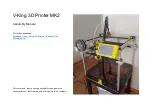
C-6
Appendix - C --- Scanner Terms
Noise
A term used to describe the occurrence of pixels
that contain random colors within an image.
Original
The paper, negative, slide, or film to be scanned.
Palette
The set of colors available for an image.
PICT
A file format for pictures used primarily on the
Macintosh.
Pixels Per Inch (ppi)
A measurement of resolution for scanners, where
the individual element is a square picture element
(pixel).
Pixels
The word pixel is a combination of the two words
picture and element. It is the smallest building
block within a scanned line-art or photographic im-
age. A pixel is the small square picture element that
is filled with a color, black or white. The value of a
pixel depends on the luminance of the area, and
is either a single bit for a black and white image,
or multi-bit for a color or gray-tone image. Pixels
come in various sizes and their size is expressed
in terms of resolution. Resolution is measured in
pixels per inch (ppi) or the equivalent dots per inch
(DPI.)
PostScript
A computer language developed by Adobe (R) Sys-
tems, Inc. for printing text, graphics, and scanned
images. PostScript (R) is a vector format that can
include scanned bitmapped images.
Raster File
Also called Raster Image or Bitmapped Image. A
picture composed of individual dots (picture ele-
ments, pixels) the way a scanner perceives it. The
rows in a high-resolution raster file typically contain
200 or 300 dots per horizontal inch of the original
drawing, and there are typically 200 or 300 rows
per vertical inch. As each of these dots is defined
by location, and by whether it is on or off, raster im-
ages generally result in large data files.
Resolution of a Scanner
Expressed as DPI (dots per inch) or the equivalent
ppi (pixels per inch). The higher the resolution of a
scanner, the smoother the scanned images.
Resolution
A measure of how many pixels per inch are
scanned. Generally, more pixels per inch means
more detail in the picture and a larger file when
saved. Defines the level of detail that can be
captured or shown by a scanner, display, or output
device. For scanners, the resolution is defined
by the number of dots (pixels) per inch (DPI) that
can be captured horizontally and vertically, e.g.
300 DPI equals 90,000 pixels per square inch.
Screen Resolutions are normally 72 pixels per inch
of screen. Additional detail is thrown away by the
screen display driver, anyway. For Printer Resolu-
tion scans, you need 150 dots per inch and above
for good results on the printed output. One must
find the level of detail that is still visible in printed
output on the printer in question, and not dramati-
cally increase the size of a saved file without bet
-
tering the result.
RGB
Red, Green, Blue. These additive primary colors
are the basic elements of white light. By mixing
them on a computer monitor or in a scanned image
file, other colors can be created. For instance, Red
and Green produces Yellow, and equal amounts of
all three produce gray.
RIP
Raster Image Processor. A RIP is a special soft-
ware that converts scanned images into a color
dithered (halftone) image that can be output
directly. An image must be ‘ripped’ before it can be
output on a CMYK device, e.g., an inkjet printer.
Rotate
To turn the picture left (clockwise) or right (coun-
terclockwise) from the orientation in which it was
scanned.
Runlength Encoding
A method of compressing raster or bitmap data by
representing “runs” of white or black dots along a
scanned line as the number of dots in each run.
Many variations of this scheme exist, with varying
compression efficiency. Typically, runlength com
-
pression formats yield a file 20-25% the size of an
uncompressed file.
Saturation
The level of colorfulness of the picture. A picture
with high saturation has vivid color. A black and
white picture has zero saturation. The purity of a
color or the degree to which it is diluted with white
light. Red is a highly saturated color. Pink is a
diluted red (has lower saturation).
Saturation is one attribute of color in the color
space called HSV (Hue Saturation, Value). Satura-
tion is a characteristic indicating the vibrancy or
intensity of a hue. A color with high saturation will
appear more intense than the same color with less.
Scale
To reduce or enlarge the size of a picture propor-
tionally.
Scanner Calibration
A program that helps adjust the scanner to achieve
stable colors and work with a printer. Calibration
gives better scanning results. The program should
be run whenever changing printing equipment,
toner, and inks, and whenever getting poor results
when printing pictures.
Содержание SD 3600 series
Страница 1: ...Technical Service Guide for SD3600 FSM TSG 001 1 3 ...
Страница 6: ...vi ...
Страница 7: ...Introduction ...
Страница 10: ...1 4 Introduction ...
Страница 11: ...Design Design ...
Страница 12: ...2 6 Design Design Electronics Block Diagram Wiring Diagram Circuit board layout s CIS Unit Construction ...
Страница 14: ...2 8 Design Wiring Diagram ...
Страница 18: ...2 12 Design ...
Страница 19: ...Troubleshooting Troubleshooting ...
Страница 25: ...Part replacement ...
Страница 28: ...4 10 Part replacement Identifying parts ...
Страница 43: ...Appendix A WIDEsystem service ...
Страница 53: ... A 11 Appendix A Test 44 License System Tab for test related to Part replacement Test 1 Scanner Information ...
Страница 54: ...A 12 Appendix A ...
Страница 55: ...Appendix B Firmware download ...
Страница 60: ...B 6 Appendix B ...
Страница 61: ...Appendix C Scanner Terms Appendix C Scanner Terms ...
Страница 69: ...Appendix D Error codes Appendix D Error codes ...
Страница 76: ...D 8 Appendix D Error codes ...
Страница 77: ...Appendix E Scanner License Appendix E Scanner License ...
Страница 85: ... E 9 Appendix E Scanner License ...
















































